Ever since the NSW government announced the decision to ban greyhound racing, the amount of misinformation that the industry and its supporters have spewed forth would be funny in all its ill-informed glory if it wasn’t so pervasive in the media. As a community service, the Coalition for the Protection of Greyhounds busts the top 10 myths making the rounds in the pro-greyhound racing camps.
1. It’s just a few bad apples.
Wishful thinking. It wasn’t just a few bad apples who ignored live baiting, overbred and killed healthy young dogs, tolerated lousy living conditions for greyhounds and neglected proper socialisation and training (to live happily as a pet, not just to race), resulting in greyhounds that would later on be euthanised for being ‘unsuitable for rehoming’. It was an entire industry.
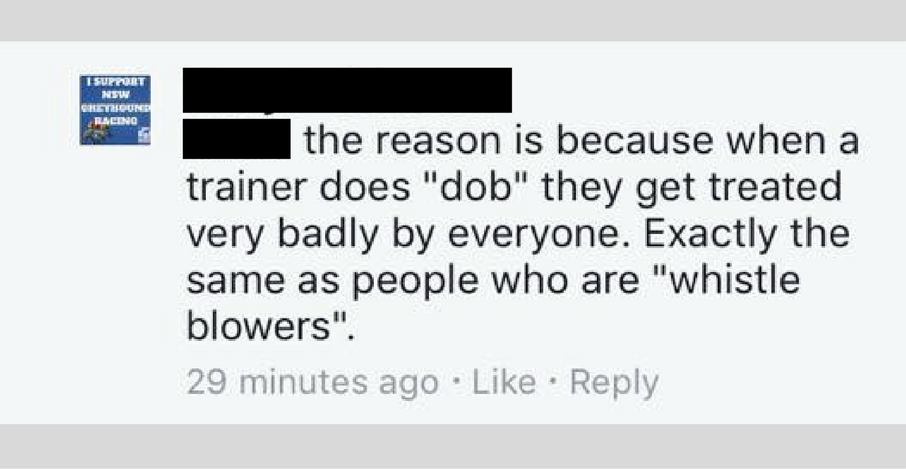
Live baiting was so accepted that people were openly selling rabbits at Appin track and nobody reported it to the authorities. (See p.58 of the Inquiry report Vol.1.) Dogs getting injured while training, trialling or racing is so common that industry participants are completely desensitised to it – they may claim that they feel upset when a dog breaks his or her leg, but that doesn’t stop them from putting the next dog at risk.
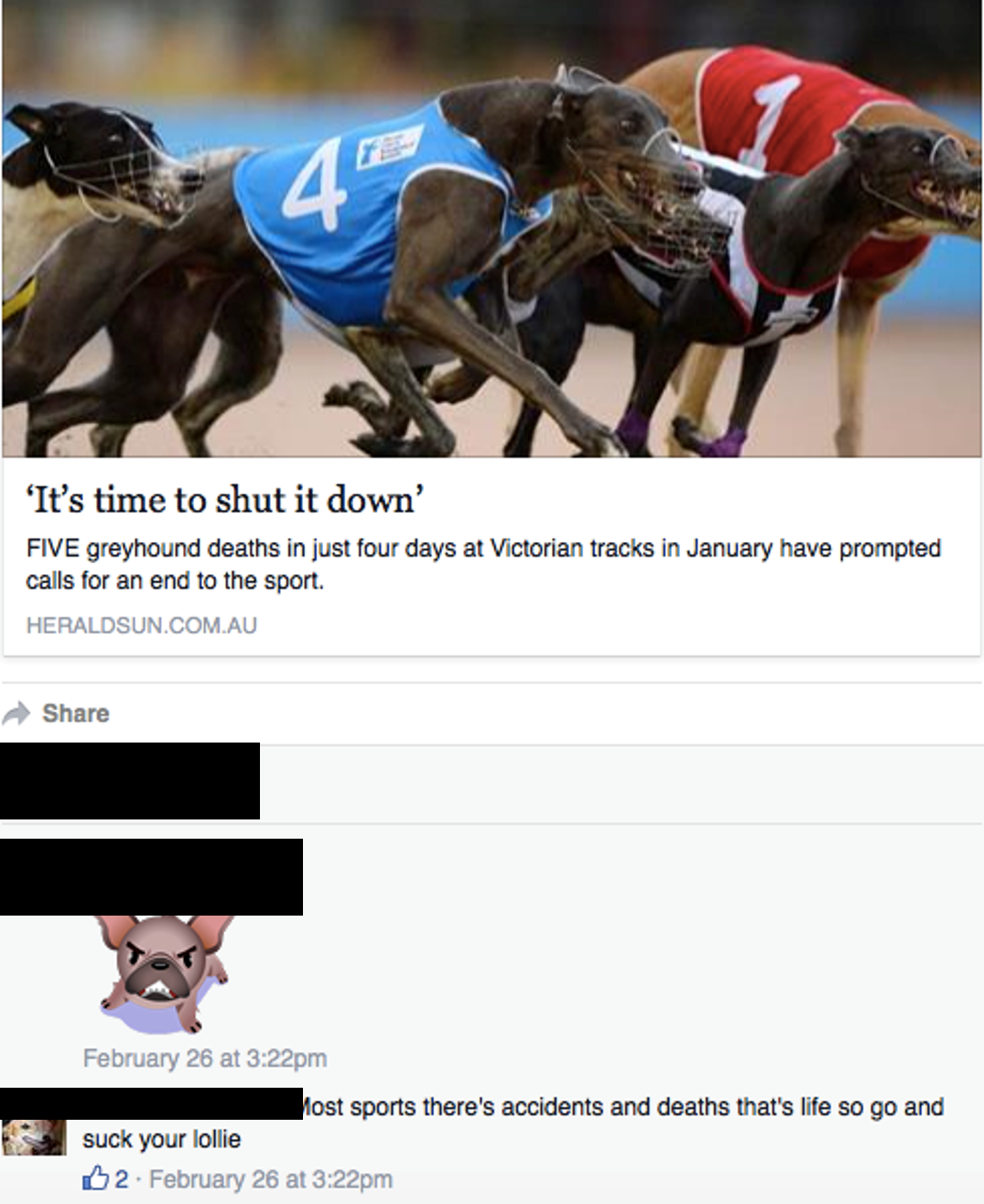
Known live baiter’s comment on Herald Sun article about greyhound deaths on the trackAs we’ve said before: you can’t change people who think they’re not doing anything wrong. The only option is to shut it down.
2. “But we love our dogs.”
Then keep them. Something that seems to have eluded the industry participants sobbing their eyeballs out on the news is that the government is actively encouraging them to keep their greyhounds as pets. Greyhound trainers, owners and breeders, nobody is coming to take your beloved dogs away from you – the government is not going to send a SWAT team into your kennels to jail-break all your greyhounds. All that this ban means is that you can no longer race them – an activity which has a 50% injury rate per dog over its lifetime.
Before any industry supporters shout “LIES!”, this is based on GRNSW’s injury report and calculated as the risk to the individual dog over the span of his or her racing career. Sorry to disappoint you. Read more here.
When you truly love your dogs, you don’t risk their safety just for your own personal gratification. When you truly love your dogs, you don’t put them down or dump them at the animal shelter just because you can’t use them to make money anymore. Prove you really love your dogs and keep them, cherish them as companions and commit to looking after them throughout their entire natural lifespan.
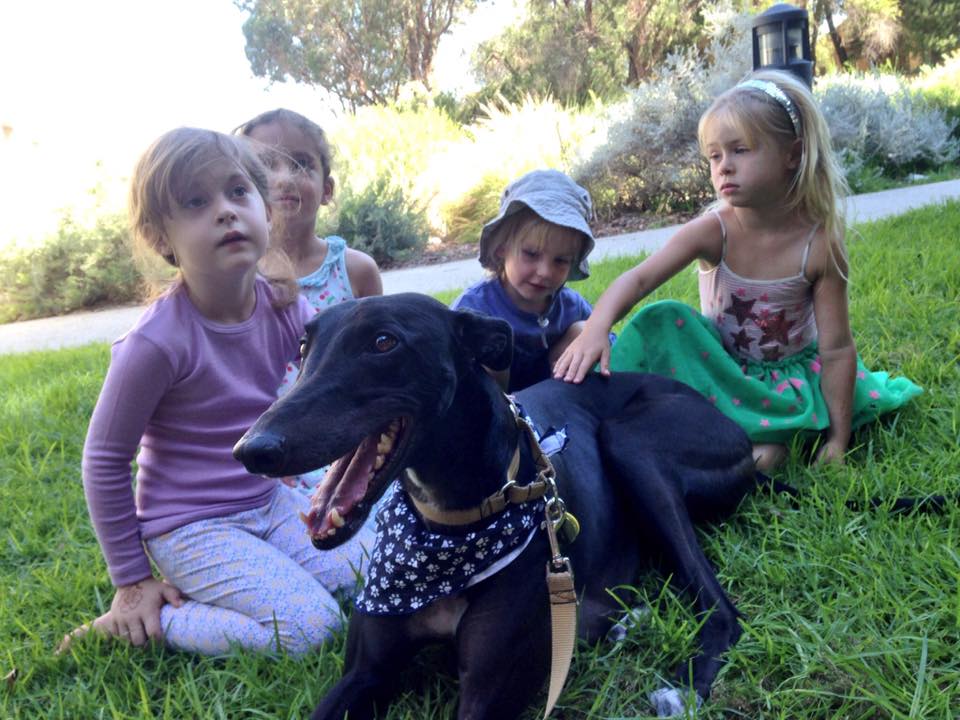
3. All the dogs will die because of the greyhound racing ban.
Greyhounds are already dying in their thousands every year – just look at what NSW, a single state, has been breeding and rehoming over the last decade:

GRNSW, in its submission to the Special Commission of Inquiry, said they had drastically reduced breeding and brought the number of puppies bred down to 1,590 puppies whelped from 01 Jan – 30 Apr 2016. Sounds great, until you realise that GAP NSW has rehomed just 593 dogs between 2007 and early 2016. Furthermore, GRNSW admits that in spite of its proposed efforts to reduce breeding and cut the number of races, it anticipates that it will not be able to rehome more than 10% of the greyhounds produced by the industry in any year (See p.3 and p.7 of the Inquiry report Vol.1.)
The only reason why dogs will die is because their owners, trainers or breeders decide they would rather euthanise their greyhounds than shelter them and feed them until permanent homes can be found for them. The NSW government is offering industry participants who rely on greyhound racing for income an adjustment package similar to what normal people would get if they were being made redundant as well as financial support to look after the dogs; RSPCA NSW has waived surrender fees so that participants can dump their dogs in RSPCA shelters without paying a cent. This level of assistance for the dogs has never been seen before anywhere.
We are realistic enough to know that not every greyhound in NSW can be saved, but it is not because greyhound racing is being banned. It is because the people who should be caring for them until they can be rehomed have chosen instead to cut their innocent lives short – as they have done for years on end, without ever being held accountable for it until now. Have a look at this greyhound trainer’s attitude towards killing their own dogs:

This greyhound trainer has obviously not bothered with socialisation or training, resulting in dogs who are supposedly unsuitable for rehoming. (This person’s qualifications to make this determination are doubtful; given that they are responsible for damaging these dogs in the first place, it is obvious that they do not know much about dogs or best practice care.) These dogs would have been put down anyway even if racing continued, because eventually they would have to retire – the only difference is that this trainer would have replaced them with other young dogs who would in time meet the same fate. The ban is the only thing stopping this trainer from damaging and killing even more dogs.
The ban does not cause the killing – it stops the cycle of breeding, exploiting and discarding greyhounds.
4. Tens of thousands of jobs will be lost.
An exaggeration by the Greyhound Breeders, Owners and Trainers Association (GBOTA), who last year were claiming that a vast majority of participants are hobbyists when they were trying to downplay the motivation to live bait (i.e. prize money). GRNSW employs 79 people while greyhound racing clubs employ 52 full-time workers. The clubs also, over a period of 18 months, paid for 511 part-time or casual positions. Access Economics estimates the total employment in the industry to be 1,561 full-time equivalent positions, of which 1,086 were direct and 475 indirect. (See p.13 of the Inquiry report Vol.1.)
Frankly speaking, GBOTA is just making wild claims about job losses because it is trying to defend an indefensible industry.
The few industry participants who do rely on racing for income (we’ll assume GBOTA’s first claim from 2015 is closer to the truth given Access Economics’ findings) are being given an entire year to find a new job as well as financial assistance. While losing your job is never fun, how many other people get the same lengthy notice period when they are made redundant?
To put this in perspective, the demise of car manufacturing in Australia will cause nearly 200,000 people to lose their jobs and none of them were routinely engaging in animal welfare transgressions that resulted in the closure of their industry.
5. “Greyhound racing people were not allowed to contribute to the inquiry.”
This is either a lie or ignorance. People involved in the industry can and did contribute to the Special Commission of Inquiry: just looking at the list of public hearings will show how many industry people gave evidence to the Inquiry. This included GRNSW employees (past and present), various greyhound trainers who gave evidence on live baiting, the Shire of Kempsey ranger who was putting greyhounds down for free for his racing buddies and former industry veterinarians. (One of the latter is Dr Greg Bryant, who described the appalling things he witnessed as a track vet in NSW on a must-watch episode of 7.30.)
In the course of its Inquiry, the Commission has received and reviewed over 151,000 pages of documentary material, and over 115 hours of videos and other recordings, from widespread sources including greyhound racing industry participants and representative organisations, welfare organisations and members of the general public. The Commission received 804 general submissions and 59 responses to issues papers it published seeking input from the industry and the public about the breeding of greyhounds, the social contribution of greyhound racing and governance of the industry in NSW.
In addition, the Commission examined 43 witnesses in 11 days of private hearings and 26 witnesses in 10 days of public hearings. The Commission has also considered the 1,143 submissions that were made to the NSW Parliamentary Select Committee in 2013 concerning the greyhound racing industry and had the benefit of reading the two Reports issued by the Select Committee in 2014.
Multiple calls for submissions were made while the Inquiry was in session and Commissioner McHugh, in his opening address on 10 June 2015, went as far as to give greyhound racing participants a phone number to call if they would like to give information. If industry participants chose not to bother writing in or phoning up, that’s their fault – nobody else’s.
6. This is a land grab!
As the days rolled on after the ban was announced, conspiracy theories began to abound as industry participants were simply unable to face the fact that their own actions had brought about the ban. One of these conspiracy theories is that the evil Liberal Premier Mike Baird was banning greyhound racing just to get his greedy hands on Wentworth Park.
Now, excuse us while we laugh our heads off. This rumour is so ludicrous that it is amazing how many people have been repeating it. If all the NSW government wanted was Wentworth Park, it would be cheaper, easier and far less controversial to simply move the track. This has been done before in Queensland on the Gold Coast when the government moved the track to make way for a hospital.
As it is, Premier Baird has publicly declared that any tracks on Crown land will be repurposed as public spaces for the community and not sold for development. The “land grab” rumour lives on though, as greyhound racing participants continue to live in denial about their industry’s dismal animal welfare record.
7. This is an attack on Aussie battlers!
The greyhound racing industry’s next conspiracy theory was that the ban is a ‘class war’ by ‘inner-city elitists’ against ‘salt-of-the-earth country folk’, romanticising itself as a group of ‘Aussie battlers’ who are ‘doing it tough’ and who deserve ‘a fair go’. Nonsense. Greyhound racing is being banned because it cannot co-exist with greyhound welfare.
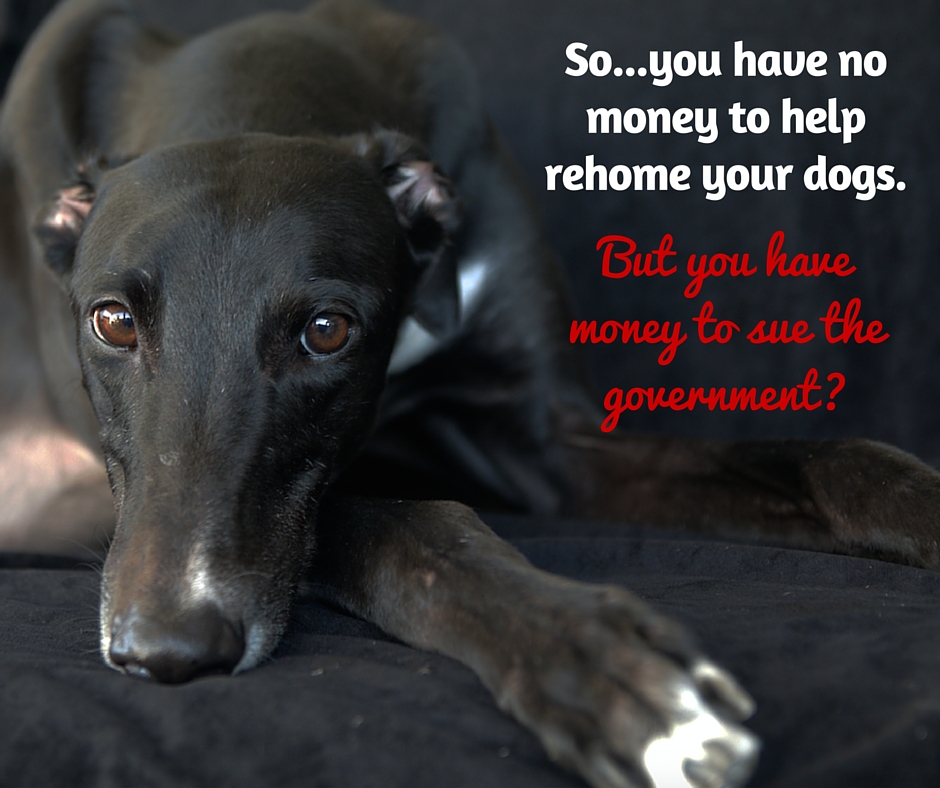
Besides, GBOTA has publicly announced that it has “tens of millions of dollars” to fight the ban – doesn’t sound like they’re ‘doing it tough’ to us. It is very telling that even though they are ‘cashed up’ to fight the government with an army of lobbyists, lawyers and spin doctors and have paid for full-page ads in newspapers and to form their own political party, they have spent nothing on initiatives to rehome their dogs or build sanctuaries for greyhounds discarded by industry participants. When quizzed about the future of the greyhounds, industry participants simply say they will die if the industry doesn’t get its way in overturning the ban. (It’s really more like a hostage situation.)
If you want to talk about real Aussie battlers, talk to volunteer-run greyhound rescue groups who have been cleaning up the industry’s mess for years using their own hard-earned paycheques to foot the bill for vetwork, kennelling fees, food, bedding, clothing, etc. Buzzfeed interviewed a few:
- Lorraine Ramsay on NSW’s Central Coast has spent half of her salary over the last 3 years rehoming discarded greyhounds. She has saved around 170 dogs so far.
- Peter and Janet Flann from Greyhound Rescue in Sydney have sacrificed their retirement and resources to save over a thousand greyhounds in the past decade.
- Lisa White, founder of Friends of the Hound, has personally cared for over 600 greyhounds in her own family home but says, “The hardest part is knowing that you can never save them all.”
And these are just a few people in NSW. There are countless more greyhound rescuers across Australia who sacrifice their time, money, labour and mental and emotional health to save the dogs thoughtlessly discarded by the greyhound racing industry. It’s about time this industry stopped offloading the dogs they exploit for profit onto compassionate, kind-hearted Australians.
8. “Our wastage rate is only 6.9%.”
Fairytale. This figure was sourced from a lengthy but mathematically incorrect article in The Australian. Various pro-racing pages started off remembering to qualify that statement with “6.9% unnecessarily euthanised by participants with 25 or less dogs” but that morphed into “The entire industry only euthanises 6.9% of all greyhounds” in less than a week – oops. Isn’t it embarrassing when you can’t even be consistent in your misinformation?
Fortunately, the Special Commission of Inquiry report (which is incredibly detailed and well-researched) actually does investigate wastage quite thoroughly. The Commission wrote that it is not enough to just compare the number of greyhounds born to the number of greyhounds named for racing and conclude that all the unnamed dogs are wastage. Instead, they wanted to know the outcomes of NSW greyhounds whelped between 01 Jan 2011 – 31 Dec 2013 to see where these dogs were by Sep 2015. (We highly recommend you read p.16 – 23 of this report to see for yourself.)
GRNSW commenced “The R106 Project” in Oct 2015 and handed in its final report in Jan 2016. The report included dogs who were born in 2011 – 2013 but excluded any of these dogs who were still racing in 2015 or who had been transferred to new owners; a total of 11,167 greyhounds. Out of these 11,167 dogs, 3,326 greyhounds’ outcomes were not traceable because of inadequate information, owner transfers to people who no longer held licences and so on. This left 7,841 greyhounds whose outcomes were known (70.2% of the target population). 2,039 of these greyhounds had owners who had compliantly handed in their R106 forms (‘Notification of Retirement’ forms) to GRNSW voluntarily as required.
5,802 of these greyhounds had owners who did not comply and only handed in their R106 forms when GRNSW cracked down on them so that GRNSW could meet its requirements to the Inquiry. Industry participants were threatened with fines, frozen prize money and the loss of right to nominate dogs for races if they did not comply. Given that the industry was subject to negative media coverage and poor public opinion at the time, there was significant temptation for these participants to provide information that would be more ‘palatable’. GRNSW itself was aware of this; the General Manager of Compliance in charge of this project wrote:
“Deceased by snakebites seems to be the excuse of choice for owners who can’t remember who they transferred their dogs to or who have killed their dogs.”
In the final report of the R 106 Project of 15 January 2016, the Project Manager recommended that areas for further investigation by the intelligence unit should include prevalence of “snake bite, parvovirus, ticks, etc.”
As such, take the figures from the non-compliant owners below with a pinch of salt. They were not given the option to say they could not remember what happened to their dogs and were feeling the heat from the media spotlight at the time when GRNSW was forcing them to provide this information. However, whether they were honest or not when they filled out those forms, the sobering fact remains that 70% of these dogs were dead before the age of 5:
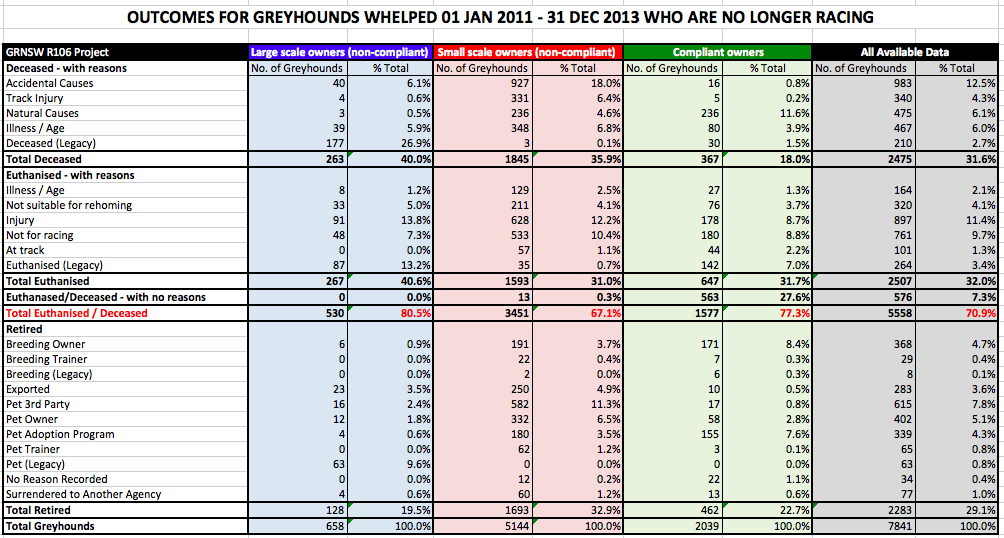
9. The RSPCA euthanises 43% of dogs!
This is nothing but a blatant lie. Unlike the greyhound racing industry, RSPCA Australia actually does publish its statistics publicly every year without the government having to form a Special Commission of Inquiry to force them to be transparent. The RSPCA euthanised 14.52% of the dogs it received in 2014-15 (view report here). Not great, but definitely not 43%.
This comparison is a simply an apple-and-orange comparison that aims to distract you from the ugly reality of greyhound racing. Why? Well, for starters, the RSPCA is a charity while greyhound racing is an industry that in theory makes a profit like any other business. The RSPCA cannot turn away dogs dumped on its doorstep regardless of the animal’s condition (mental or physical), unlike the industry-run GAP who can reject greyhounds that fail its temperament tests. Some of these dogs that are rejected by GAP end up in the RSPCA’s shelters or council pounds. And most importantly, the RSPCA breeds 0 dogs while the industry breeds thousands every year. Is the RSPCA perfect? No. Does this mean we should just ignore the greyhound racing industry’s ingrained problems? Still a resounding “NO”.
10. Live baiting isn’t a problem anymore, so greyhound racing should continue.
While live baiting was the issue that made the nation sit up and take notice of what greyhound welfare advocates had been saying for years, it is not the only issue in the greyhound racing industry. (Still a huge issue though – click here to view a history of live baiting.) Other animal welfare problems like doping, poor living conditions, the mass slaughter of healthy young dogs, unacceptably high injury rates and a culture of placing animal welfare last render this industry unfixable.
Take, for example, the issue of socialisation – industry participants often will not socialise and train the greyhounds in their care outside of what needs to be done for racing. This means that basic things like exposing these dogs to urban noises, children, other kinds of animals, car rides and living in a home (not a kennel) are neglected, and the dog pays the price when he or she can no longer race and is discarded to a rehoming group or GAP. They may be euthanised as ‘unsuitable for rehoming’ or require rehabilitation through the fostering process.
The right thing to do would be for participants to not damage these dogs in the first place, but they are unlikely to do this purely because it is too costly to do so:
RSPCA Australia informed the Commission that implementing a broad-scale socialisation program would require considerable resources, staff, external expertise and time. This was unlikely to be financially viable. It referred to the Association of Shelter Veterinarians’ “Guidelines for Standards of Care in Animal Shelters”. These guidelines recommend a minimum of 15 minutes of care time per day just for feeding and cleaning each dog housed (nine minutes for cleaning and six minutes for feeding). RSPCA Australia noted that, if 40 greyhounds were present, a minimum of ten hours per day would be required for basic care. On a rearing property with 100 pups this would equate to a minimum of 25 hours per day of staff time. RSPCA Australia estimated that four full-time staff would be required just for feeding and cleaning. If a conservative estimate of one hour per day was required for socialisation of each pup, there would be 13 full-time staff dedicated to socialisation alone each day.
One of NSW’s largest breeders and rearers, Mr Paul Wheeler, informed the Commission that he employed 13 full-time staff. He also informed the Commission that there were approximately 484 greyhounds located on his property. If RSPCA Australia’s estimates are correct, then he has insufficient resources to carry out what is required.
We share the opinion of the Commission that greyhound racing must be banned because once the media spotlight is off the industry, no real change will happen and animal welfare transgressions will continue. The regulator’s inability to monitor participants effectively and frequently, the industry’s ingrained culture of placing animal welfare last and the impossibility of maintaining a profitable industry while properly funding the care of greyhounds add up to one clear conclusion: banning greyhound racing is the right choice. As Premier Baird said, it was a hard thing to do – but it’s the right thing to do.
Download this blog as an infographic
Cruelty does not stop at the border. Please click here to support the RSPCA South Australia’s efforts to get an inquiry into greyhound racing in South Australia.